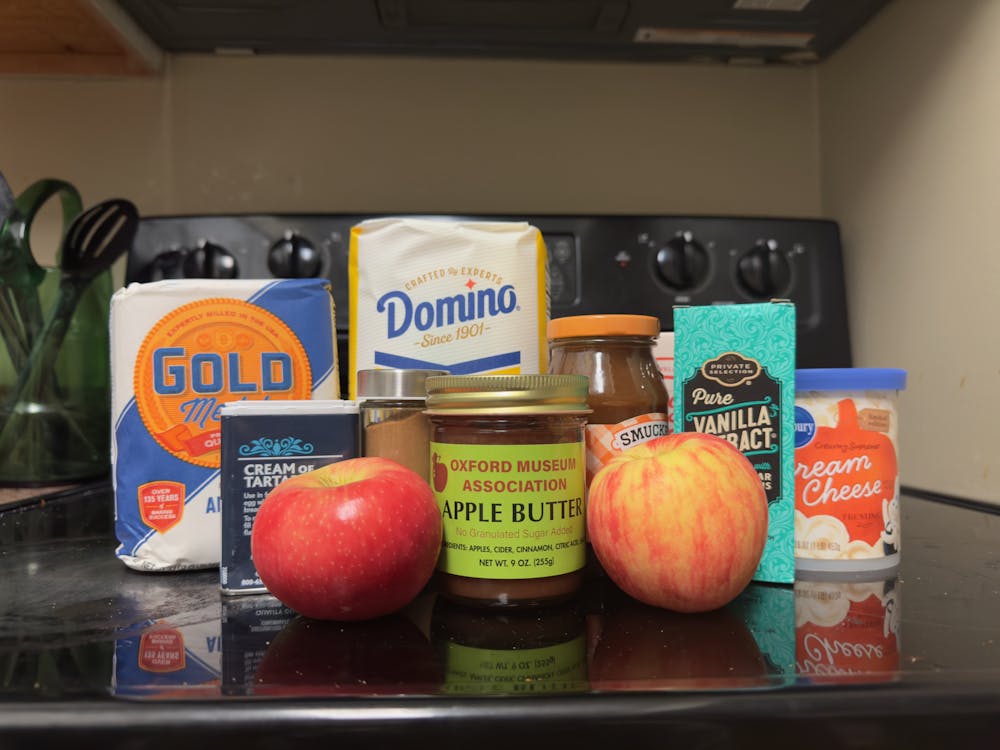Fall: It’s the season of orange and red leaves falling down, students donning flannels and an abundance of pumpkin-spiced coffees.
It’s also the season of the Oxford Museum Association’s annual Apple Butter Festival.
This past weekend, hundreds of Miami University students and residents, as well as parents visiting for the weekend, made their way to Doty Farmstead at Hueston Woods to take part in the festivities.
I’ve never had apple butter, so this year I made it my mission to not only go, but to actually try the staple food of the weekend. After I picked up my jar, I headed home to search for a recipe to use it in.
I settled on a combination of two cookie recipes — one made with apple butter, the other with chunks of apple — and got my supplies. An embarrassing amount of money later (I owned no baking ingredients before this excursion), I was ready, and I headed over to Opinion Editor Devin Ankeney’s apartment to make use of their better kitchen and get baking.
Our modified recipe drew from a Dixie Crystal apple butter cookie recipe and a Scientifically Sweet recipe for caramel apple cookies. This turned out to be a mistake — more on that later.
Step one: Literally just put butter in the bowl
The apple butter cookie recipe called for us brave souls to “Cream butter, apple butter, and sugar on low speed until mostly incorporated.” The recipe called for room-temperature, ready-to-be-mixed butter.
Sean started to cream the butter (by mashing it with the spoon against the side of the bowl), but it was definitely too cold to start. We persevered anyway, without a microwave in sight. The butter was still as cold as it had been in the Kroger refrigerator.
Editor’s note: the microwave was immediately to the right of Sean and Devin.
This step took much longer than it should have, mostly due to user error. The sad butter was left chunky by the end of our efforts, but we decided to keep going and pretend it wasn’t that important.
Enjoy what you're reading?
Signup for our newsletter
Step two: Mix in the vanilla extract and egg

Devin Ankeney and Sean Scott should have been looking at the bowl, not the camera, while mixing.
Other than Sean’s instinctual pull to ignore the recipe and simply guess how many eggs went into the cookies, this step was our best yet.
We eventually agreed on one egg, and with the vanilla extract, our bowl of ingredients was starting to really come together (except for the dozens of chunks of butter floating around unmelted).
Step three: Try to mix dry ingredients together without spilling flour
As Devin continued to stir together the wet ingredients, Sean moved on to the dry bowl.
The flour was in a pitifully small little bag, and the 1-cup measuring cup barely fit inside. This became a problem as Sean refused to problem-solve and instead brute-forced the cup to fit, throwing off the measurements.
He then added extra flour for the extra vibes.
The baking soda proved to be the toughest challenge. Sean couldn’t open it, and the spoon got stuck. Devin nearly dumped the whole thing out, but we got it sorted in the end and the dry ingredients were mixed together with minimal casualties.
Step four: Throw everything together

Sean Scott stirs the viscous mixture, hoping the cookies turn out alright.
I (Devin) can’t emphasize this enough. The recipe called for us to “slowly add dry ingredients” to the bowl of buttery goodness. Slowly.
Sean took the first turn at dumping the dry ingredients while I vigorously stirred. He dumped far too fast. I became frustrated.
We swapped roles.
You would think that I would have learned a lesson from Sean’s speedy pouring, resulting in a poop-adjacent mixture that was nearing unstoppable.
I did not.
I proceeded to dump the mixture even faster than Sean had, resulting in our first sizable spill of flour of the experiment.
The cookie mix was complete. Crushed it.
Step five: Go home, pretend this never happened, wake up the next morning and finally bake the cookies

Sean and Devin taste-test the "cookie" dough, much to Devin's distaste.
The recipe called for chilling the dough for at least two hours, so Sean packed it up in a bowl, took it home and threw it in the fridge for the night. The next morning, Devin came over to assist in the final step: actually baking the cookies.
The dough settled like clay, holding far too much of its shape and looking about as appealing as the last apple from a journey to the orchard three weeks ago. When we started to form little balls of dough, it quickly became apparent that this was not a real dough.
We’ve brainstormed a few potential reasons for this post-mortem. We almost definitely ended up with too much flour, throwing off the balance. Adding the apple chunks also messed with the water content. We clearly aren’t bakers, and we failed to account for how our changing ingredients would impact the overall recipe.
Still, we managed to get two big cookies and nine pitifully normal-sized cookies in the oven and watched them rise beyond our wildest expectations.
Final step: Eat cookie

Devin tastes Apple Butter Cookie 2.0: a cookie with more frosting than actual cookie.
The last step in our extravagant plan was to taste-test our masterpiece. We decided to have our first bite without any toppings other than a light sprinkling of cinnamon sugar.
They were … less than enthusing.
At worst, the “cookies” tasted like a piece of bread that was sprayed — at a distance — with a cheap apple–scented juice. At best, the cookies tasted like 5/10 apple bread.
Luckily, we had a secret weapon on our side: far too much cream cheese frosting.
Calamity: averted.
The final product was a delicious, unmitigated success, with intense amounts of frosting to bury the sad little bread cookies.
The experience was certainly memorable. Repeatable? Up for debate. Maybe next time we’ll follow the recipe a little more closely. Or, well, at all.




